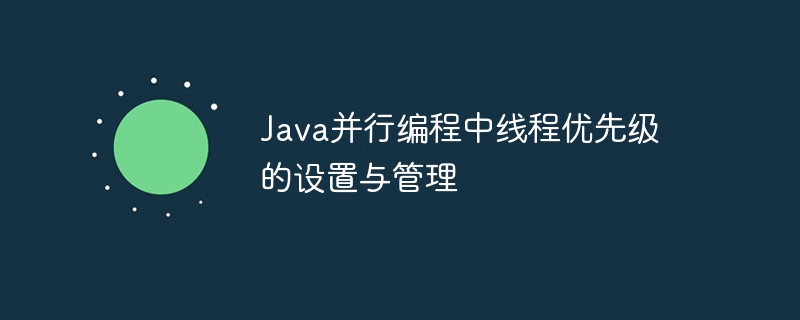Setting and management of thread priority in Java parallel programming
Setting and managing Java thread priorities helps optimize the performance and responsiveness of multi-threaded applications. By using the Thread.setPriority() method, developers can set the thread priority from 1 (lowest) to 10 (highest). The Java virtual machine uses scheduling algorithms (such as non-preemptive and preemptive) to determine the order of thread execution. By setting different priorities, key tasks can be executed in time under high load, thereby improving the overall performance of the application, as shown in the case: key tasks are set to the highest priority, and low-priority tasks are set to the lowest priority, ensuring Critical tasks preempt execution time when necessary.

Thread priority setting and management in Java parallel programming
In multi-threaded applications, thread priority management allows developers to control thread scheduling sequence to optimize application performance and responsiveness. This article will introduce the setting and management of thread priority in Java, and provide a practical case to demonstrate its application.
Setting of thread priority
The priority of Java thread is set using the Thread.setPriority() method, which accepts a value between Thread.MIN_PRIORITY# An integer between ##(1) and Thread.MAX_PRIORITY(10).
thread.setPriority(Thread.MAX_PRIORITY);
- Non-preemptive scheduling: Higher priority threads run until completion or blocking, and then lower priority threads can run.
- Preemptive scheduling: A thread with a higher priority can preempt the execution time of a running low-priority thread.
// 创建一个高优先级线程来处理关键任务
Thread highPriorityThread = new Thread() {
@Override
public void run() {
// 执行关键任务
}
};
highPriorityThread.setPriority(Thread.MAX_PRIORITY);
// 对于其他线程,设置较低的优先级
Thread lowPriorityThread = new Thread() {
@Override
public void run() {
// 执行低优先级的任务
}
};
lowPriorityThread.setPriority(Thread.MIN_PRIORITY);The above is the detailed content of Setting and management of thread priority in Java parallel programming. For more information, please follow other related articles on the PHP Chinese website!

Hot AI Tools

Undresser.AI Undress
AI-powered app for creating realistic nude photos

AI Clothes Remover
Online AI tool for removing clothes from photos.

Undress AI Tool
Undress images for free

Clothoff.io
AI clothes remover

Video Face Swap
Swap faces in any video effortlessly with our completely free AI face swap tool!

Hot Article

Hot Tools

Notepad++7.3.1
Easy-to-use and free code editor

SublimeText3 Chinese version
Chinese version, very easy to use

Zend Studio 13.0.1
Powerful PHP integrated development environment

Dreamweaver CS6
Visual web development tools

SublimeText3 Mac version
God-level code editing software (SublimeText3)

Hot Topics
 1386
1386
 52
52
 Perfect Number in Java
Aug 30, 2024 pm 04:28 PM
Perfect Number in Java
Aug 30, 2024 pm 04:28 PM
Guide to Perfect Number in Java. Here we discuss the Definition, How to check Perfect number in Java?, examples with code implementation.
 Weka in Java
Aug 30, 2024 pm 04:28 PM
Weka in Java
Aug 30, 2024 pm 04:28 PM
Guide to Weka in Java. Here we discuss the Introduction, how to use weka java, the type of platform, and advantages with examples.
 Smith Number in Java
Aug 30, 2024 pm 04:28 PM
Smith Number in Java
Aug 30, 2024 pm 04:28 PM
Guide to Smith Number in Java. Here we discuss the Definition, How to check smith number in Java? example with code implementation.
 Java Spring Interview Questions
Aug 30, 2024 pm 04:29 PM
Java Spring Interview Questions
Aug 30, 2024 pm 04:29 PM
In this article, we have kept the most asked Java Spring Interview Questions with their detailed answers. So that you can crack the interview.
 Break or return from Java 8 stream forEach?
Feb 07, 2025 pm 12:09 PM
Break or return from Java 8 stream forEach?
Feb 07, 2025 pm 12:09 PM
Java 8 introduces the Stream API, providing a powerful and expressive way to process data collections. However, a common question when using Stream is: How to break or return from a forEach operation? Traditional loops allow for early interruption or return, but Stream's forEach method does not directly support this method. This article will explain the reasons and explore alternative methods for implementing premature termination in Stream processing systems. Further reading: Java Stream API improvements Understand Stream forEach The forEach method is a terminal operation that performs one operation on each element in the Stream. Its design intention is
 TimeStamp to Date in Java
Aug 30, 2024 pm 04:28 PM
TimeStamp to Date in Java
Aug 30, 2024 pm 04:28 PM
Guide to TimeStamp to Date in Java. Here we also discuss the introduction and how to convert timestamp to date in java along with examples.
 Java Program to Find the Volume of Capsule
Feb 07, 2025 am 11:37 AM
Java Program to Find the Volume of Capsule
Feb 07, 2025 am 11:37 AM
Capsules are three-dimensional geometric figures, composed of a cylinder and a hemisphere at both ends. The volume of the capsule can be calculated by adding the volume of the cylinder and the volume of the hemisphere at both ends. This tutorial will discuss how to calculate the volume of a given capsule in Java using different methods. Capsule volume formula The formula for capsule volume is as follows: Capsule volume = Cylindrical volume Volume Two hemisphere volume in, r: The radius of the hemisphere. h: The height of the cylinder (excluding the hemisphere). Example 1 enter Radius = 5 units Height = 10 units Output Volume = 1570.8 cubic units explain Calculate volume using formula: Volume = π × r2 × h (4
 Create the Future: Java Programming for Absolute Beginners
Oct 13, 2024 pm 01:32 PM
Create the Future: Java Programming for Absolute Beginners
Oct 13, 2024 pm 01:32 PM
Java is a popular programming language that can be learned by both beginners and experienced developers. This tutorial starts with basic concepts and progresses through advanced topics. After installing the Java Development Kit, you can practice programming by creating a simple "Hello, World!" program. After you understand the code, use the command prompt to compile and run the program, and "Hello, World!" will be output on the console. Learning Java starts your programming journey, and as your mastery deepens, you can create more complex applications.




